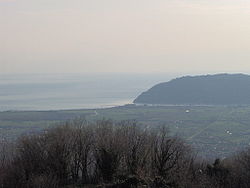Luni (Italy)
| Luni | |
|---|---|
| Frazione | |

The plain of Luni and the village
|
|
| Location of Luni in Italy | |
| Coordinates: 44°04′00″N 10°02′00″E / 44.06667°N 10.03333°ECoordinates: 44°04′00″N 10°02′00″E / 44.06667°N 10.03333°E | |
| Country |
|
| Region |
|
| Province | La Spezia (SP) |
| Comune | Ortonovo |
| Elevation | 20 m (70 ft) |
| Population (2001) | |
| • Total | 1,000 |
| Demonym(s) | Lunensi |
| Time zone | CET (UTC+1) |
| • Summer (DST) | CEST (UTC+2) |
| Postal code | 19034 |
| Dialing code | (+39) 0187 |
Luni is a small town under the comune (municipality) of Ortonovo, province of La Spezia, in the easternmost end of the Liguria region of northern Italy. It was founded by the Romans as Luna. It gives its name to Lunigiana, a region spanning eastern Liguria and northern Tuscany (province of Massa-Carrara). Points of interest include remains of the elliptical Roman amphitheatre (1st century AD) and the Archaeological Museum.
Located in a plain near the Tyrrhenian Sea and close to the borders with Tuscany, Luni is crossed by the river Magra and lies between Sarzana (7 km in north) and Carrara (5 km in south). It is 4 km far from Ortonovo, 15 from Massa and 30 from La Spezia. The village is served by the National Highway 1 "Aurelia", crossed at Luni Mare by the A12 motorway and counts a railway station on the Pisa-Genoa line.
Luna was the frontier town of Etruria, on the left bank of the river Macra (now Magra), the boundary in imperial times between Etruria and Liguria. When the Romans first appeared in these parts, however, Etruscans and the Ligurians were already in possession of the territory.
The city was established in 177 BC by Publius Aelius, Marcus Aemilius Lepidus and Gnaeus Sicinius Located at the mouth of the Magra, it was a military stronghold for the campaigns against the Ligures. An inscription of 155 BC, found in the forum of Luna in 1851, was dedicated to M. Claudius Marcellus in honor of his triumph over the Ligurians and Apuani. In 109 BC it was connected to Rome by the Via Aemilia Scauri, rebuilt in the 2nd century AD as the Via Aurelia. It flourished when exploitation of white marble quarries in the nearby Alpi Apuane and neighboring mountains of Carrara, which in ancient times bore the name of Luna marble.. Pliny speaks of the quarries as only recently discovered in his day; they were soon owned by the imperial family. Pliny the Elder considered the big wheels of cheese from Luna the best in Etruria. Good wine was also produced.
...
Wikipedia

